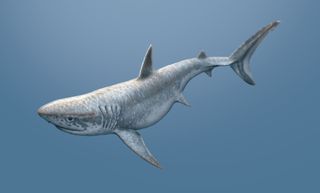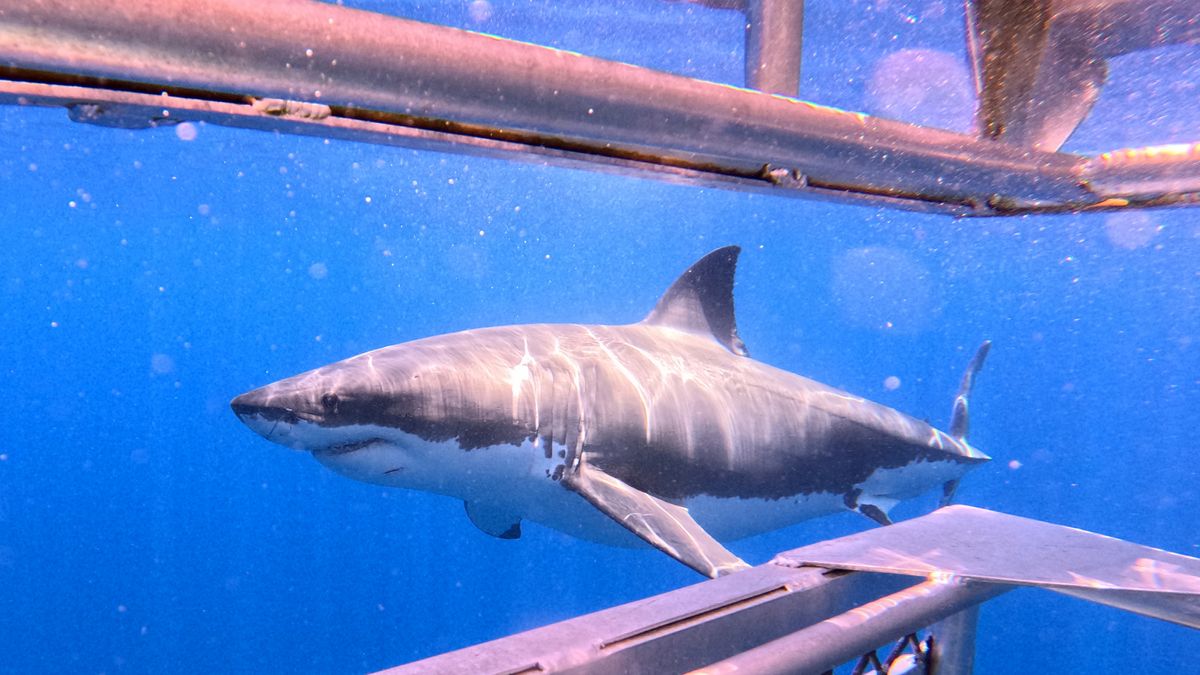Sharks are some of the most successful, fierce and mysterious predators our world has ever known. With a history spanning around half a billion years, the shark bloodline has produced the mighty megalodon; the bizarre, buzz-saw-jawed Helicoprion; and the fearsome great white shark. So how have they done it?
John Long, a paleontology professor at Flinders University in Australia, has been researching ancient sharks and other fossilized fish for more than 40 years. In his latest book, “The Secret History of Sharks” (Ballantine Books, 2024), Long tells the incredible story of shark evolution. He spoke to Live Science about what he’s learned.
Patrick Pester: Sharks have been around for about half a billion years. How have they survived so long?
John Long: They’ve been resourceful and adaptive. They’re the only group of backboned, jawed creatures on the planet to have survived all five major mass extinction events. And it’s not a matter of them saying, “Oh, there’s a massive extinction event coming; I’ll have to whip up some new adaptation.” It’s that at any time these mass extinction events struck, there was enough variety in sharks that at least some lineages of them got through.
As they developed a superior body plan, which they did by the Devonian period [419 million to 359 million years ago], sharks then looked a lot like sharks today. That body plan allowed them to diversify a lot more rapidly, so each mass extinction event had less and less of an effect on them from that point on.
They also started diversifying in the Devonian period to develop crushing types of tooth plates, as well as sharp, piercing, tearing and slicing teeth. They even developed filter feeding well before any other vertebrates. So they’ve always had this ability to be very plastic with their dental development, creating new tooth types and new tooth tissues. That’s been one of their biggest saving graces, almost like a Swiss Army knife kind of dentition, of adaption, that they could adapt to any sort of food resource that was around.
Related: A really big shark got gobbled up by another, massive shark in 1st known case of its kind
PP: We don’t want to give too much away, but can you share something you uncovered as part of this book that researchers didn’t know before?
JL: Absolutely. A lot of the research I treated as investigative journalism with my background in fish evolution and shark evolution. I’ve published several papers describing new species of sharks, and I’ve dug them up myself — so I have that experience. I was able to contact all of my colleagues who are experts in all the different fields of shark evolution and interview them. Gradually, a lot of them opened up and shared with me research in press that hadn’t even gone to print when I wrote the book. Now, a lot of those papers have come out, but I was able to muse on that and build it into the book well before it was public knowledge.
I got all the new information about megalodon [Otodus megalodon], the greatest predator that ever lived. They’re just amazing. A lot of the new research that was just recently published was about the fact that it was warm-blooded. Researchers proved its body temperature through clumped isotope paleothermometry, which is measuring the temperature that the [isotope] bonds form at when the cartilage is forming. They can look at living sharks and get that temperature range, then apply the same geochemistry to fossils and get an accurate range of what the body temperature was. Now we know that megalodon had a body temperature of about 27 degrees Celsius [80 degrees Fahrenheit].

PP: What does that mean for the shark if it’s warm-blooded?
JL: It means that it can go places other sharks can’t go. It can go into colder waters — further south or further north. We’ve got remains of megalodon teeth from all around the globe — everywhere except Antarctica. There are Pliocene [5.3 million to 2.6 million years ago] fossil sites in Antarctica that are from the age when megalodon was still around and in its prime, and those sites have whale fossils but no megalodon teeth at all. I put this together and think that maybe whales started migrating down to Antarctica as a way of escaping from megalodons and having a safe sanctuary to feed and then came back to the warmer waters to give birth.
PP: There are still some gaps in the shark fossil record. What do you think is the biggest open question in shark evolution research?
JL: For the first 56 million years of shark evolution, we’ve got very little [fossil evidence]. We’ve only got some scales to start with in the Ordovician period [485 million to 444 million years ago]. It’s not until the Devonian period, around 419 million years ago, that we start getting shark teeth in abundance in the fossil record and we find the first complete fossil sharks. That’s when our knowledge of sharks really picks up.
The big question is, what is the relationship between sharks and placoderms like Dunkleosteus, these armored fishes that ruled the roost in the Silurian and Devonian periods [444 million to 359 million years ago] and went extinct at the end of the Devonian, when sharks really blossomed?
A new discovery out of China from the early Silurian is a fish called Shenacanthus, which is shark-like, having shark-like dorsal fin spines, but it’s got armored plates around the head, like the placoderms. We don’t have the jaws, so we don’t have the teeth — we don’t know if it even had teeth — but it could be a good example of these really early sharks that we only know from scales and fin spines.
There are all these mysteries: Did placoderms give rise to sharks by losing armor, or did sharks gain armor and become placoderms?
PP: A study earlier this year estimated that humans now kill up to 80 million sharks a year. You’ve described sharks as nature’s great survivors, but can they survive us?
JL: That’s the ultimate question I pose in the book. And what can we learn from sharks as ultimate survivors? In the book, I use a conservative figure and say between 70 [million] and 100 million sharks a year are killed through the shark finning industry alone, and it’s terrible. It’s a horrible way for the sharks to die. They just cut the fins off and throw the living shark back in the water to die a slow, painful death.
Some countries, like the U.K., are banning shark finning and the import of shark fin products. Other countries need to follow. That’s the only way we can stop it. In Asian countries like China, where shark fin soup was the delicacy of the ancient dynasties, people are becoming more environmentally aware and starting to turn away from these old traditions that actually are decimating the planet.
My hope is that more information and more education to the public about this horrible practice will see people just refuse to support shark fin soup sellers. I certainly won’t go to any restaurant if I know that’s on the menu. I also hope countries will collaborate in terms of enforcing legislation.
PP: Do you think your book will help with rehabilitating the public image of sharks by giving a more three-dimensional view of what they are, as opposed to just mindless killers?
JL: Exactly. Ever since “Jaws,” we’re all terrified to go in the water — myself included. But they’re beautiful things. I was invited to go on a shark tour to see the great whites [Carcharodon carcharias] myself off the Neptune Islands of South Australia — the same area where they filmed the live scenes for “Jaws.” I was at first a bit apprehensive and a bit terrified. But I eventually got in the shark cage, and I started seeing this beautiful, big white shark swimming around. She was not the least bit interested in me, just focused on the tuna bait they were throwing out.
I spent a total of seven or eight hours over the course of three days there, watching maybe half a dozen different white sharks. I was amazed at how individual they all were, the individual personalities, the individual battle scars and wounds that they all bore. They’ve each got a life story, and each one deserves a chance at life as much as we do.
This interview has been condensed and edited for clarity.
